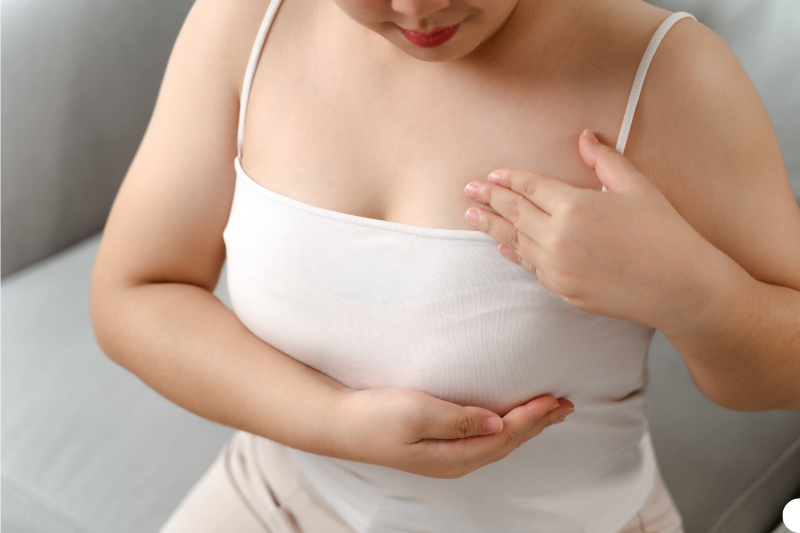It’s widespread for women to have slightly asymmetrical or uneven breasts, with one breast bigger or smaller than the other by some degree. Having some amount of size variance between breasts proves perfectly normal for most women.
While very pronounced differences can occasionally indicate an underlying health issue needing evaluation, minor asymmetries frequently stem from simple factors like regular developmental breast changes over time. There are a few common explanations for why are my breasts uneven:
1. Hormonal Shifts
Hormonal fluctuations during puberty, monthly menstruation cycles, pregnancies, and menopause transitions can stimulate glandular breast tissue growth patterns differently over time, resulting in asymmetry that emerges despite identical genetics. These differences typically self-correct post-weaning or once cycles stabilize.
2. Breastfeeding Patterns
While breastfeeding, uneven draining habits mean milk production increases more prolifically within a favored side. Extended feeding can then translate into subtle breast size variances that remain permanent for the long term.
3. Weight Gain and Loss
As BMI drops substantially or body fat percentages rise, breasts often shrink and expand disproportionately as tissues change, creating asymmetry despite even gains/losses across bodies. Give new shapes time to settle before determining if proportional imbalances prove permanent or temporary.
4. Injuries and Surgeries
Partial mastectomy cancer surgeries, past physical trauma from earlier accidents or biopsies assessing lumps impacting singular breasts unequally can instigate aesthetic asymmetry that, if sufficient glandular tissues or structural damages result from procedural healing or tissue removal itself, sparing one side intact.
Asymmetrical Breasts Solutions
Thankfully, if asymmetry appears more pronounced than ideal preferences aesthetically, practical at-home solutions help better balance proportions comfortably:
1. Wear Well-Fitted Bras
Rather than fuller figures spilling outward uncomfortably, invest in well-fitted asymmetrical bras with fully adjustable shoulder straps, multiple closure hooks and removable padding inserts to enhance shape symmetry through strategic lift and coverage precision.
2. Use Light Padding Strategically
Try wearing removable padded inserts housed within pockets on the smaller cup side to temporarily balance visual proportions without permanence. Gradually reduce padding thickness as natural breast sizes evolve closer over subsequent years, especially post-weaning.
3. Seek Angled Push-Up Specialty Bras
While excessive push-up padding risks breast tissue damage in the long term, innovative specialty bras utilizing angled cups and detailed strap adjustments aim to achieve nonsurgical lift through strategic distribution and custom alignments, making the most of a woman’s uniquely gorgeous anatomical endowments.
4. Weigh Implant Options Realistically
Rather than salivating over excessive implant sizing alone falsely advertised online, make respectful plastic surgery consultations focused thoughtfully on idealized outcomes factoring reasonable asymmetry improvements and proportional limitations, managing expectations soundly, not just generically injecting larger volumes without context.
5. Fix Rounded Shoulders
Realigning slumped shoulders or uneven chest postural holdings helps rebalance the visual landscape naturally. Chiropractors also help outwardly resolve spin/skeletal torsional shifts representing the root asymmetric cause.
6. Build Chest Muscles Gradually
Weight training routines steadily strengthen pectoral muscles similarly over time and provide natural structural lifts, reaping breast proportionality youthfully. Remember to stretch frequently and relax tense areas to loosen tightening effects from overdevelopment.
7. Nourish Breast Health Holistically
Nutritious diets rich in proteins, antioxidant vitamins E/C and assorted trace minerals better nourish and repair damaged structural tissues, improving skin resilience and supporting breasts evenly over time. Minimize stimulant chemicals, temporarily exacerbating monthly swelling fluxes.
8. Embrace Normal Aesthetic Diversity
Rather than force-feed unrealistic uniformity standards ubiquitously through media, embrace the beautiful spectrum of aesthetically diverse appearances, making womanhood wonderful. After all, minor breast shape variance naturally falls within statistically normal ranges for most women.
Conclusion
While modern standards historically glorify cookie-cutter hourglass silhouettes slimly through magazines worshipping uniformity as beauty’s highest archetype, true femininity flourishes uniquely through signature diverse incarnations as we embrace realistic aesthetic ranges compassionately once unrealistic expectations get extinguished incrementally.
Soon, self-perceptions shift, celebrating one’s classic version of womanhood again rather than faulty comparing endlessly against airbrushed ivory towers unattainable for even the most genetically gifted among us daily battling similar self-doubts vulnerably. Simply put, unevenness occurs ubiquitously to all by degree undeserving much-concerted attention beyond perspectives magnifying matters disproportionately.
If substantial discomfort physically manifests unrelated to monthly menstruation cyclicity, just ask your healthcare provider sincerely to resolve uncertainties medically or seek specialty guidance custom-tailoring cumulative care addressing more involved challenges individually. Beyond clinical considerations, focus fixations outward again on fulfilling enriching life priorities meaningfully aligned nourishing whole health toward the greater good!







